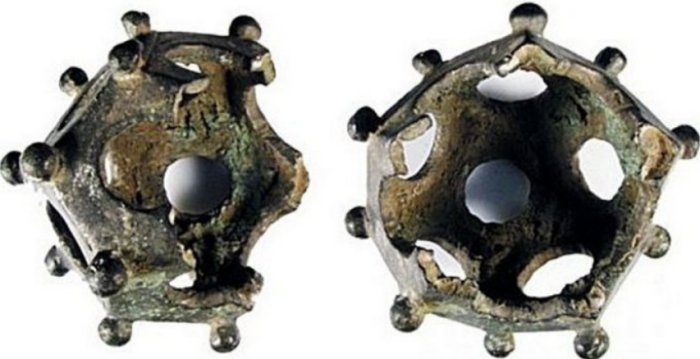Dodecahedron: Sophisticated Ancient Device Found In Europe And Asia
A. Sutherland - AncientPages.com - Over the years, almost thirty theories regarding mysterious dodecahedrons have been documented, many dismissed, and none considered satisfactory.
Roman bronze dodecahedron found in Tongeren, Gallo-Roman Museum, Tongeren, Leopoldwal, 1939, collectie Gallo-Romeins Museum Tongeren, 4002. Image credit: Public Domain
They are considered an ancient archaeological mystery despite many attempts to solve it.
The enigmatic artifact is a hollow bronze polyhedron with twelve pentagonal faces, each with a different-sized hole, thirty ridges, and twenty vertices decorated with solid balls of small diameter. It has persisted as an enigma within the annals of Gallo-Roman archaeological records to the present day. It still captivates scholars and researchers alike.
More than a hundred enigmatic objects have been discovered on Roman sites in Great Britain, Belgium, Germany, France, Italy, Luxembourg, Netherlands, Austria, Switzerland, Eastern Europe, and even Asia in Thailand, Burma, and Vietnam.
It is noteworthy to mention that these structures have also been unearthed in Asia, but on a considerably smaller scale, at locations such as Taxila in the Punjab province of Pakistan, Gummadiduru in India, and China and Vietnam.
However, they exhibit distinct characteristics that differ from those of the European dodecahedrons. For instance, those originating from Vietnam and India are crafted from gold, with diameters ranging from 4 to 9 millimeters and weights frequently less than a gram. Additionally, the holes drilled into the faces are of uniform diameter. These objects were believed to have symbolic significance rather than any practical application.
This discovery expands the geographical scope and significance of these archaeological findings.
The discovery of the European dodecahedron has occurred in diverse and remarkable locations, including riverbeds, public baths, a well military camps, a tomb, a hoard, a temple, and even within the confines of a well that had been filled.
The purpose behind the enigmatic distribution of this intriguing artifact is to ensure its visibility to as many individuals as possible. This deliberate distribution adds to the mystery surrounding its origin, leading to various theories about its use and significance in the ancient world.
The purpose of these odd objects, commonly known as Roman dodecahedrons, has been widely discussed. They are between four and eleven centimeters in size and date from the Roman Empire, between the 2nd and 3rd centuries. Interestingly, they have yet to learn what they were used for.
Did the Romans create these dodecahedrons, or were they named 'Roman' because many were unearthed in countries once part of the Roman Empire? This question raises exciting possibilities about their origin and purpose.
The artifact's origin is also unclear because it was never mentioned in the Roman, thoroughly kept accounts.
Two ancient Roman bronze dodecahedrons and an icosahedron (3rd c. AD) in the Rheinisches Landesmuseum in Bonn, Germany. The dodecahedrons were excavated in Bonn, Frechen-Bachem, and one icosahedron in Arloff. Image credit: Kleon3 - CC BY-SA 4.0 DEED
Some of the proposed suggestions regarding the device's use are possible. Still, it has yet to be explained why a relatively sophisticated device would be used instead of alternative means to achieve the desired function successfully.
Despite much speculation, the dodecahedron's function has not been scientifically determined. Some have suggested that it was a surveying instrument.
Some of these artifacts were discovered within coin chests, suggesting they held value for the Romans. Two other artifacts had remnants of wax inside. Were the objects used as flower stands, finger ring-size gauges, amulets, game dice, or even toys to throw and catch on a stick? They may have been candle holders in certain rituals; however, their peculiar shape seems ill-suited for this purpose, raising questions about their intended function.
In 1849, the Society of Antiquaries of London wrote that "A singular object of bronze, in the form of a hollow dodecahedron… with a ball attached to each angle; each of its pentagonal sides is pierced with a circular opening, the diameters of these perforations increasing gradually from six-tenths to about 1 ½ inch.
The 12-sized geometric artifacts (widely known as' Roman dodecahedrons' have been long-lasting enigma för archaeologists. Photo credit: British Museum
"Each side measures, in diameter, 2 1/5 inches. It was found in May 1768, at a depth of about 8 feet, on the north side of St. Peter's Church, Carmarthen. Several pieces of copper, curiously laid in flag bricks, were found at the same time, but they crumbled to dust.
"A similar bronze dodecahedron, found with copper coins at Aston, in Hertfordshire, in a field called Hagdale, was exhibited to the Society by Mr. North, June 28, 1739.
"A third, resembling these but of smaller size, and without balls at the angles, found near Fishguard, was sent by the Rev. Edward Harries of Llandysilio, Pembrokeshire, March 12, 1846."
What did our greatest minds of the ancient world think about the dodecahedron?
Plato vaguely wrote that the god used the dodecahedron to arrange the constellations in heaven. On the other hand, Aristotle added a fifth element, aither (aether in Latin), and suggested a theory that the heavens were made of this element. Still, he had no interest in matching it with Plato's fifth solid.
As for Pythagoras, this mysterious complex object was perceived as a symbolic representation of the Cosmos, of the Universal Sphere, a notion that Plato subsequently embraced.
Notably, the dodecahedron with equal faces can be inscribed within a sphere, a geometrical property that undoubtedly contributed to its philosophical significance.
Recently, people have suggested that the dodecahedron represents "a sacred symbol for Druids," but Plutarch (c. 46 – 120 AD), a Greek historian, biographer, and essayist, identified it as a vital instrument for zodiac signs. According to him, the twelve sides represent the twelve animals in the circle of the Zodiac and the twelve months. The thirty edges correspond to the number of days a month, and the multiplication of these two numbers gives 360.
An important question is: on what basis did Plutarch make this identification? One must also ponder the peculiar protrusions—were they merely ornamental embellishments, or did they hold any substantive significance?
The objects do not appear in any surviving pictures of the time, although they can be found in museums and many private collections. The dodecahedron remains a mystery.
Written by – A. Sutherland - AncientPages.com Senior Staff Writer
First version of this article appeared on AncientPages.com on May 14, 2014.
Copyright © AncientPages.com All rights reserved. This material may not be published, broadcast, rewritten or redistributed in whole or part without thexpress written permission of AncientPages.com
Expand for referencesReferences:
Phillips, J. P. “The History of the Dodecahedron.” The Mathematics Teacher 58, no. 3 (1965): 248–50.
Klarreich, Erica. “The Shape of Space.” Science News 164, no. 19 (2003): 296–97.
More From Ancient Pages
-
 Ruins Of Biblical City Of Corinth Discovered Underwater – Giant Monuments and Remains Of Lighthouse Still Well-Preserved
Archaeology | Dec 19, 2017
Ruins Of Biblical City Of Corinth Discovered Underwater – Giant Monuments and Remains Of Lighthouse Still Well-Preserved
Archaeology | Dec 19, 2017 -
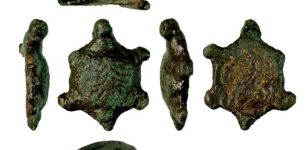 Roman Copper-Alloy Tortoise Figurine Discovered In Suffolk, UK
Archaeology | Dec 4, 2023
Roman Copper-Alloy Tortoise Figurine Discovered In Suffolk, UK
Archaeology | Dec 4, 2023 -
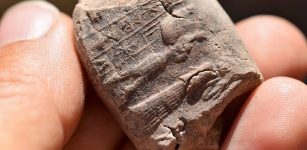 Old Babylonian Residential Building In Ur Dated To 1835 BC – Investigated
Archaeology | Jul 24, 2019
Old Babylonian Residential Building In Ur Dated To 1835 BC – Investigated
Archaeology | Jul 24, 2019 -
 On This Day In History: Samurai Final Battle of Shiroyama Was Fought – On Sep 24, 1877
News | Sep 24, 2016
On This Day In History: Samurai Final Battle of Shiroyama Was Fought – On Sep 24, 1877
News | Sep 24, 2016 -
 On This Day In History: The Battle of Mortimer’s Cross – On Feb 2, 1461
News | Feb 2, 2017
On This Day In History: The Battle of Mortimer’s Cross – On Feb 2, 1461
News | Feb 2, 2017 -
 Mythical Place Where Gorgon Medusa Dwelled And Was Killed May Have Been Found By Archaeologists
Featured Stories | Sep 15, 2024
Mythical Place Where Gorgon Medusa Dwelled And Was Killed May Have Been Found By Archaeologists
Featured Stories | Sep 15, 2024 -
 What Is The Codex Sinaiticus And What Does It Mean?
Ancient History Facts | Feb 5, 2019
What Is The Codex Sinaiticus And What Does It Mean?
Ancient History Facts | Feb 5, 2019 -
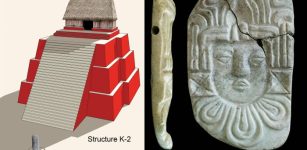 Fire-Burning Event At The Maya Kingdom Of K’anwitznal Was A Reaction To Regime Change
News | Apr 19, 2024
Fire-Burning Event At The Maya Kingdom Of K’anwitznal Was A Reaction To Regime Change
News | Apr 19, 2024 -
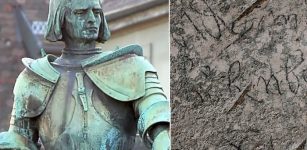 A Graffiti Inscription With The Name Of Knight Adrian von Bubenberg – Found On Mount Zion In Jerusalem
Archaeology | Nov 30, 2022
A Graffiti Inscription With The Name Of Knight Adrian von Bubenberg – Found On Mount Zion In Jerusalem
Archaeology | Nov 30, 2022 -
 Why Napoleon’s Invasion Of Russia Was A Fiasco
Ancient History Facts | Mar 31, 2017
Why Napoleon’s Invasion Of Russia Was A Fiasco
Ancient History Facts | Mar 31, 2017 -
 Persephone: Greek Goddess Of The Coming Spring And Lady Of The Land Of The Dead
Featured Stories | Jun 26, 2021
Persephone: Greek Goddess Of The Coming Spring And Lady Of The Land Of The Dead
Featured Stories | Jun 26, 2021 -
 Seppuku: Ancient Suicide Ritual That Guaranteed Honorable Death Instead For Life In Shame
Ancient Traditions And Customs | Mar 8, 2018
Seppuku: Ancient Suicide Ritual That Guaranteed Honorable Death Instead For Life In Shame
Ancient Traditions And Customs | Mar 8, 2018 -
 Largest Figurine Workshop Yet Discovered In The Maya World
Archaeology | Apr 30, 2019
Largest Figurine Workshop Yet Discovered In The Maya World
Archaeology | Apr 30, 2019 -
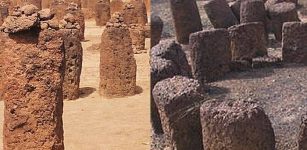 Senegambia’s Circles: Largest Cluster Of Megalithic Structures Of Lost Civilization On Earth
Featured Stories | Jan 3, 2020
Senegambia’s Circles: Largest Cluster Of Megalithic Structures Of Lost Civilization On Earth
Featured Stories | Jan 3, 2020 -
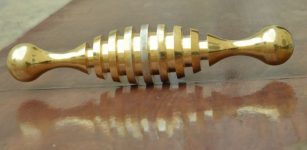 History Mystery: Gold Tool Found In Jerusalem Cemetery Baffles
Archaeology | Dec 25, 2015
History Mystery: Gold Tool Found In Jerusalem Cemetery Baffles
Archaeology | Dec 25, 2015 -
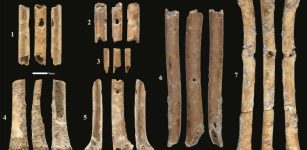 12,000-Year-Old Flutes Made From Bird Bones – Discovered
Archaeology | Jun 10, 2023
12,000-Year-Old Flutes Made From Bird Bones – Discovered
Archaeology | Jun 10, 2023 -
 Location Of Elusive Spanish Fort Is Now Verified By Florida And Georgia Archaeologists
Archaeology | Apr 24, 2020
Location Of Elusive Spanish Fort Is Now Verified By Florida And Georgia Archaeologists
Archaeology | Apr 24, 2020 -
 House Of Dragons – Stories And British History That Inspired The Beasts Of Westeros
Featured Stories | Sep 18, 2022
House Of Dragons – Stories And British History That Inspired The Beasts Of Westeros
Featured Stories | Sep 18, 2022 -
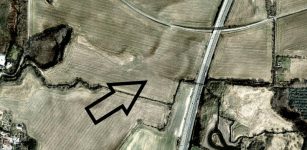 Archaeologists Uncover Secrets Of ‘Vallø Borgring’ Viking Age Circular Fortress
Archaeology | Oct 11, 2015
Archaeologists Uncover Secrets Of ‘Vallø Borgring’ Viking Age Circular Fortress
Archaeology | Oct 11, 2015 -
 Unexplained Ancient Wars In America – Knowledge Of Ancient High-Tech Weapons? – Part 1
Featured Stories | Sep 29, 2020
Unexplained Ancient Wars In America – Knowledge Of Ancient High-Tech Weapons? – Part 1
Featured Stories | Sep 29, 2020




